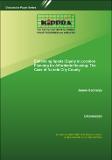| dc.description.abstract | The affordable housing programme is being implemented by the Government of Kenya to address housing adequacy challenges in the country. Access to affordable and decent housing is imperative to improving the quality of life of Kenyans and ensuring human dignity. The choice of location for the construction of housing can either enhance or reduce equity in access to housing and services. The study sought to analyse spatial equality in housing and infrastructure provision using the City of Nairobi as a case example. Key concepts of spatial welfare, spatial equity, spatial justice and sustainable development framed the study. Using spatial analysis methods, the study first identified suitable locations (sites) for providing affordable housing. The identified sites were then evaluated for prioritization and decision-making using the spatial multi-criteria evaluation method. Criteria for analysis were identified from the literature and prioritized using a participatory approach; that is, Analytic Hierarchy Process (AHP). The study finds that prioritization of criteria and the consequent determination of weights or relative importance differs based on the background of stakeholders. For instance, what local citizens define as a priority may not be given the same weight by professionals or Government project officials. This highlights the nature of the ‘decision problem’ in planning and providing affordable housing units. There is observed spatial inequality concerning access or coverage of physical and social infrastructure. Locations have been identified that are less equity enhancing and would further adversely affect the lives and well-being of targeted beneficiaries, barring any affirmative infrastructure interventions. The findings are instrumental in planning and budgeting and prioritization in the allocation of resources for housing and infrastructure development. | en |

